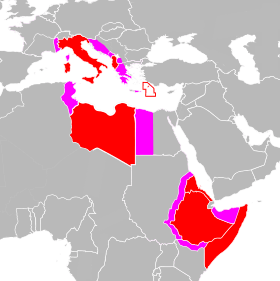Italian Libya
| Italian Libya | ||||||
| Libia Italiana ليبيا | ||||||
| Protectorates of Italy (1912–1934)[1] Colony of Italy (1934–1943) | ||||||
| ||||||
| ||||||
 Green: Territory annexed by Italy. Light green: Libyan Sahara territory. Dark gray: Other Italian possessions and occupied territory. Darkest gray: Kingdom of Italy. | ||||||
| Capital | Tripoli | |||||
| Languages | Italian (official) Libyan Arabic, Berber languages, Domari | |||||
| Religion | Islam, Coptic Orthodoxy, Judaism, Catholicism | |||||
| Government | Colonial administration | |||||
| Monarch | ||||||
| • | 1911-43 | King Victor Emmanuel III | ||||
| History | ||||||
| • | Established | 1911 | ||||
| • | Disestablished | 1943 | ||||
| Area | ||||||
| • | 1939[2] | 1,759,541 km² (679,363 sq mi) | ||||
| Population | ||||||
| • | 1939[2] est. | 893,774 | ||||
| Density | 0.5 /km² (1.3 /sq mi) | |||||
| Currency | Italian lira | |||||
| Today part of | | |||||
Italian Libya (Italian: Libia Italiana; Arabic: ليبيا الإيطالية Lībyā al-Īṭālīya) was a unified colony of Italian North Africa (Africa Settentrionale Italiana, or ASI) established in 1934[3] in what is now modern Libya. Italian Libya was formed from the colonies of Cyrenaica and Tripolitania which were taken by Italy from the Ottoman Empire in 1912 after the Italo-Turkish War of 1911 to 1912.
History
Conquest
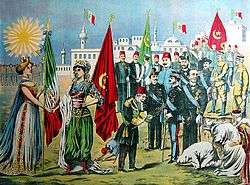
The history of Libya as an Italian colony started in 1911 and was characterized initially by a major struggle with Muslim native Libyans that lasted until 1931. During this period, the Italian government controlled only the coastal areas of the colony. Between 1911 and 1912, over 1,000 Somalis from Mogadishu, the then capital of Italian Somaliland, served as combat units along with Eritrean and Italian soldiers in the Italo-Turkish War.[4] Most of the troops stationed never returned home until they were transferred back to Italian Somaliland in preparation for the invasion of Ethiopia in 1935.[5]
After the Italian Empire's conquest of Ottoman Tripolitania (Ottoman Libya), in the 1911–12 Italo-Turkish War, much of the early colonial period had Italy waging a war of subjugation against Libya's population. Ottoman Turkey surrendered its control of Libya in the 1912 Treaty of Lausanne, but fierce resistance to the Italians continued from the Senussi political-religious order, a strongly nationalistic group of Sunni Muslims. This group, first under the leadership of Omar Al Mukhtar and centered in the Jebel Akhdar Mountains of Cyrenaica, led the Libyan resistance movement against Italian settlement in Libya. Italian forces under the Generals Pietro Badoglio and Rodolfo Graziani waged punitive pacification campaigns which turned into acts of repression after the massacres of Italian soldiers at Sciara Sciat and other localities. Resistance leaders were executed or escaped into exile. The forced migration of more than 100,000 Cyrenaican people ended in Italian concentration camps. After two decades, Italy predominated.
In the 1930s, the policy of Italian Fascism toward Libya began to change, and both Cyrenaica and Tripolitania, along with Fezzan, were merged into Italian Libya in 1934. In the second half of the 1930s, under the Governor Italo Balbo, Italian Libya experienced a huge development.
Territorial agreements with European powers
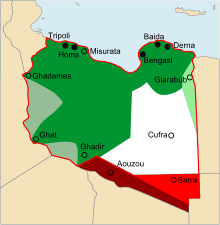
The colony expanded after concessions from the British colony of Sudan and a territorial agreement with Egypt. The Kufra district was nominally attached to British-occupied Egypt until 1925, but in fact remained a headquarters for the hostile Senussi until conquered by the Italians in 1931. The Kingdom of Italy at the 1919 Paris "Conference of Peace" received nothing from German colonies, but as a compensation Great Britain gave it the Oltre Giuba and France agreed to give some Saharan territories to Italian Libya.[6]
After prolonged discussions through the 1920s, it was not until 1935 that the Mussolini-Laval agreement was reached and Italy received the Aouzou strip that was added to Libya (but this agreement was not ratified later by France).
In 1931, the towns of El Tag and Al Jawf were taken over by Italy. British Egypt had ceded Kufra and Jarabub to Italian Libya on December 6, 1925, but it was not until the early 1930s that Italy was in full control of the place. In 1931, during the campaign of Cyrenaica, General Rodolfo Graziani easily conquered Kufra District, considered a strategic region, leading about 3,000 soldiers from infantry and artillery, supported by about twenty bombers. Ma'tan as-Sarra was turned over to Italy in 1934 as part of the Sarra Triangle to colonial Italy by the Anglo-Egyptian Condominium, who considered the area worthless and so an act of cheap appeasement to Benito Mussolini's attempts at empire.[7][7] During this time, the Italian colonial forces built a World War I–style fort in El Tag in the mid-1930s.
World War II
In 1939 some Libyans were granted special (though limited) Italian citizenship by Royal Decree No. 70 on 9 January 1939. This citizenship was necessary for any Libyan with ambitions to rise in the military or civil organizations. The recipients were officially referred to as Moslem Italians. Libya had become the fourth shore of Italy”(Trye 1998). The incorporation of Libya into the Italian Empire gave the Italian Army a greater ability to exploit native Libyans for military service. Native Libyans served in Italian formations from the beginning of the Italian occupation of Libya. On 1 March 1940, the 1st and 2nd Libyan Divisions were formed. These Libyan Infantry divisions were organized along the lines of the binary Italian infantry division. The 5th Italian Army received the 2nd Libyan Infantry division which it incorporated into the 13th corps. The Italian 10th Army received the 1st Libyan Infantry Division which it incorporated into the reserve. The Italian Libyan infantry divisions were colonial formations ("colonial" in the sense of consisting of native troops). These formations had Italian officers commanding them with Libyan NCOs and soldiers. These native Libyan formations were made up of people drawn from the coastal Libyan populations. The training and readiness of these divisions was on an equal footing with the regular Italian formations in North Africa. Their professionalism and 'esprit de corps' made them some of the best Italian infantry formations in North Africa. The Libyan divisions were loyal to Italy and provided a good combat record.[8]

After the enlargement of Italian Libya with the Aouzou Strip, Fascist Italy aimed at further extension to the south. Indeed Italian plans, in the case of a war against France and Great Britain, projected the extension of Libya as far south as Lake Chad and the establishment of a broad land bridge between Libya and Italian East Africa.[9] During World War II, there was strong support for Italy from many Muslim Libyans, who enrolled in the Italian Army. Other Libyan troops (the Savari [cavalry regiments] and the Spahi or mounted police) had been fighting for the Kingdom of Italy since the 1920s. A number of major battles took place in Libya during the North African Campaign of World War II. In September 1940, the Italian invasion of Egypt was launched from Libya.[10]
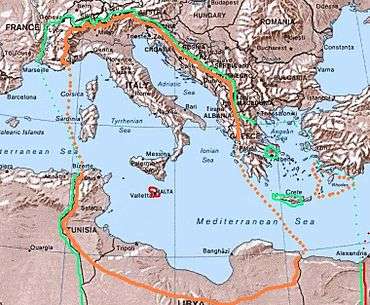
Starting in December of the same year, the British Eighth Army launched a counterattack called Operation Compass and the Italian forces were pushed back into Libya. After losing all of Cyrenaica and almost all of its Tenth Army, Italy asked for German assistance to aid the failing campaign[11]
With German support, the lost Libyan territory was regained during Operation Sonnenblume and by the conclusion of Operation Brevity, German and Italian forces were entering Egypt. The first Siege of Tobruk in April 1941 marked the first failure of Rommel's Blitzkrieg tactics. In 1942 there was the Battle of Gazala, when the Axis troops finally conquered Tobruk and pushed the defeated British troops inside Egypt again. Defeat during the Second Battle of El Alamein in Egypt spelled doom for the Axis forces in Libya and meant the end of the Western Desert Campaign.

In February 1943, retreating German and Italian forces were forced to abandon Libya as they were pushed out of Cyrenaica and Tripolitania, thus ending Italian jurisdiction and control over Libya.
After World War II

From 1943 to 1951, Tripolitania and Cyrenaica were under British administration, while the French controlled Fezzan. Under the terms of the 1947 peace treaty with the Allies, Italy relinquished all claims to Libya.[12] On November 21, 1949, the UN General Assembly passed a resolution stating that Libya should become independent before January 1, 1952. On December 24, 1951, Libya declared its independence as the United Kingdom of Libya, a constitutional and hereditary monarchy. The Italian population virtually disappeared after the Libyan leader Muammar Gaddafi ordered the expulsion of remaining Italians (about 20,000) in 1970.[13] Only a few hundred of them have been allowed to return to Libya in the 2000s.
On 30 August 2008, Gaddafi and Italian Prime Minister Silvio Berlusconi signed a historic cooperation treaty in Benghazi.[14][15][16] Under its terms, Italy would pay $5 billion to Libya as compensation for its former military occupation.[17] In exchange, Libya would take measures to combat illegal immigration coming from its shores and boost investments in Italian companies.[15][18] The treaty was ratified by Italy on 6 February 2009,[14] and by Libya on 2 March, during a visit to Tripoli by Berlusconi.[15][19] Cooperation ended in February 2011 as a result of the Libyan Civil War which overthrew Gaddafi. At the signing ceremony of the document, Italian Prime Minister Silvio Berlusconi recognized historic atrocities and repression committed by the state of Italy against the Libyan people during colonial rule, stating: "In this historic document, Italy apologizes for its killing, destruction and repression of the Libyan people during the period of colonial rule." and went on to say that this was a "complete and moral acknowledgement of the damage inflicted on Libya by Italy during the colonial era".[20]
Colonial administration

In 1934, Italy adopted the name "Libya" (used by the Greeks for all of North Africa, except Egypt) as the official name of the colony (made up of the three Provinces of Cyrenaica, Tripolitania and Fezzan). The colony was subdivided into four provincial governatores (Commissariato Generale Provinciale) and a southern military territory (Territorio Militare del Sud or Territorio del Sahara Libico):[21]
- Tripoli Province, capital Tripoli.
- Benghazi Province, capital Benghazi.
- Darnah Province, capital Derna.
- Misurata Province, capital Misrata.
- Military Territory of the South, capital Hun
The general provincial commissionerhips were further divided into wards (circondari).[21] On 9 January 1939, a decree law transformed the commissariats into provinces within the metropolitan territory of the Kingdom of Italy.[21] Libya was thus formally annexed to Italy and the coastal area was nicknamed the "Fourth Shore" (Quarta Sponda). Key towns and wards of the colony became Italian municipalities (comune) governed by a podestà.[21]
Governors-General of Libya
- Italo Balbo January 1, 1934 to June 28, 1940
- Rodolfo Graziani July 1, 1940 to March 25, 1941
- Italo Gariboldi March 25, 1941 to July 19, 1941
- Ettore Bastico July 19, 1941 to February 2, 1943
- Giovanni Messe February 2, 1943 to May 13, 1943
Demographics
In 1939, key population figures for Italian Libya were as follows:[2]
| Ethnic group | Population | % of total |
|---|---|---|
| Italians | 119,139 | 13.4 |
| Arabs | 744,057 | 83.2 |
| Jews | 30,578 | 3.4 |
| Total | 893,774 | 100 |
Population of the main urban centres:
| Town | Italians | Arabs | Jews | Total |
|---|---|---|---|---|
| Italian Tripoli | 47,442 | 47,123 | 18,467 | 113,212 |
| Italian Benghazi | 23,075 | 40,331 | 3,395 | 66,801 |
| Misrata | 1,735 | 44,387 | 977 | 47,099 |
| Derna | 3,562 | 13,555 | 391 | 17,508 |
Settler colonialism
Many Italians were encouraged to settle in Libya during the Fascist period, notably in the coastal areas.[22] The annexation of Libya's coastal provinces in 1939 brought them to be an integral part of metropolitan Italy that were the focus of Italian settlement.[23]
The population of Italian settlers in Libya increased rapidly after the Great Depression: in 1927, they were just about 26,000 of them, by 1931 they were 44,600, 66,525 in 1936 and eventually, in 1939, they numbered 119,139, or 13% of the total population.[2] They were concentrated on the Mediterranean coast, especially in the main urban centres and in the farmlands around the city of Tripoli (constituting 41% of the city's population) and Benghazi (35% of the city's population) where they found jobs in the construction boom fuelled by Fascist interventionist policies. In 1938, Governor Italo Balbo brought 20,000 Italian farmers to settle in Libya, and 27 new villages were founded, mainly in Cyrenaica.[24]
Attitudes and behaviour towards the Libyan indigenous population

With the Pacification of Libya initiated in response to a major rebellion by indigenous Libyans against Italian colonial rule, there were mass deaths of the indigenous people in Cyrenaica - one quarter of Cyrenaica's population of 225,000 people died during the conflict.[26] Italy committed major war crimes during the conflict; including the use of illegal chemical weapons, episodes of refusing to take prisoners of war and instead executing surrendering combatants, and mass executions of civilians.[27] Italian authorities committed ethnic cleansing by forcibly expelling 100,000 Bedouin Cyrenaicans, almost half the population of Cyrenaica, from their settlements that was slated to be given to Italian settlers.[28][29]
The Italian occupation also reduced the number of livestock by killing, confiscation or driving the animals from their pastoral land to inhospitable land near the concentration camps.[30] Number of sheep fell from 810,000 in 1926 to 98,000 in 1933, goats from 70,000 to 25,000 and camels from 75,000 to 2,000.[30]
From 1930 to 1931 during the Pacification, 12,000 Cyrenaicans were executed and all the nomadic peoples of northern Cyrenaica were forcefully removed from the region and relocated to huge concentration camps in the Cyrenaican lowlands.[31] Propaganda by the Fascist regime declared the camps to be oases of modern civilization that were hygienic and efficiently run - however in reality the camps had poor sanitary conditions as the camps had an average of about 20,000 Beduoins together with their camels and other animals, crowded into an area of one square kilometre.[32] The camps held only rudimentary medical services, with the camps of Soluch and Sisi Ahmed el Magrun with an estimated 33,000 internees having only one doctor between them.[32] Typhus and other diseases spread rapidly in the camps as the people were physically weakened by meagre food rations provided to them and forced labour.[32] By the time the camps closed in September 1933, 40,000 of the 100,000 total internees had died in the camps.[32]
After the full Libya pacification, the Italian government changed policy toward the local population: in December 1934, individual freedom, inviolability of home and property, the right to join the military or civil administrations, and the right to freely pursue a career or employment were guaranteed to Libyans.[33]
In a famous trip by Mussolini to Libya in 1937, a propaganda event was created where Mussolini met with Muslim Arab dignitaries, who gave him an honorary sword (that had actually been made in Florence) which was to symbolize Mussolini as a protector of the Muslim Arab peoples there.[34]
In January 1939, Italy annexed territories in Libya that it considered Italy's Fourth Shore, with Libya's four coastal provinces of Tripoli, Misurata, Bengasi, and Derna becoming an integral part of metropolitan Italy.[23] At the same time indigenous Libyans were granted "Special Italian Citizenship" which required such people to be literate and confined this type of citizenship to be valid in Libya only.[23]
In 1939, laws were passed that allowed Muslims to be permitted to join the National Fascist Party and in particular the Muslim Association of the Lictor (Associazione Musulmana del Littorio). This allowed the creation of Libyan military units within the Italian army.[35] In March 1940, two divisions of Libyan colonial troops (for a total of 30,090 native Muslim soldiers) were created and in summer 1940 the first and second Divisions of Fanteria Libica (Libyan infantry) participated in the Italian offensive against the British Empire's Egypt:[36] 1 Libyan Division Sibelle and 2 Libyan Division Pescatori.
Economy
In 1936, the main sectors of economic activity in Italian Libya (by number of employees) were industry (30.4%), public administration (29.8%), agriculture and fishing (16.7%), commerce (10.7%), transports (5.8%), domestic work (3.8%), legal profession and private teaching (1.3%), banking and insurance (1.1%).[2]
Infrastructure improvements
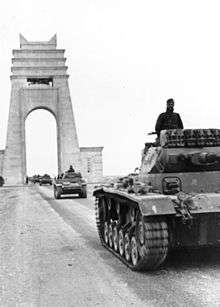
The Fascist regime, especially during Depression years, emphasized infrastructure improvements and public works. In particular, Governor Italo Balbo hugely expanded Libyan railway and road networks from 1934 to 1940, building hundreds of km of new roads and railways and encouraging the establishment of new industries and dozen of new agricultural villages)[37] The massive Italian investment did little to improve Libyan tenor of life, as the purpose was to develop the economy for the benefit of Italy and Italian settlers.[30]
The Italian aim was to drive the local population to the marginal land in the interior and to resettle the Italian population in the most fertile lands of Libya.[30] The Italians did not provide the Libyans with adequate education or improved native administration, the Italian population (about 10% of the total population) had 81 elementary schools in 1939-1940, while the Libyans (more than 85% of total population) had 97.[30] There were only three secondary schools for the Libyans by 1940, two in Tripoli and one in Benghazi.[38]
The Libyan economy substantially grew in the late 1930s, mainly in the agricultural sector. Even some manufacturing activities were developed, mostly related to the food industry. Building construction increased in a huge way. Furthermore, the Italians made modern medical care available for the first time in Libya and improved sanitary conditions in the towns.
The Italians started numerous and diverse businesses in Tripolitania and Cirenaicia. These included an explosives factory, railway workshops, Fiat Motor works, various food processing plants, electrical engineering workshops, ironworks, water plants, agricultural machinery factories, breweries, distilleries, biscuit factories, a tobacco factory, tanneries, bakeries, lime, brick and cement works, Esparto grass industry, mechanical saw mills, and the Petrolibya Society (Trye 1998). Italian investment in her colony was to take advantage of new colonists and to make it more self-sufficient. (General Staff War Office 1939, 165/b).[39]
By 1939, the Italians had built 400 kilometres (250 mi) of new railroads and 4,000 kilometres (2,500 mi) of new roads. The most important and largest highway project was the Via Balbo, an east-west coastal route connecting Tripoli in western Italian Tripolitania to Tobruk in eastern Italian Cyrenaica. Most of these projects and achievements were completed between 1934 and 1940 when Italo Balbo was governor of Italian Libya, as it became the Fourth Shore.[40]
The last railway development in Libya done by the Italians was the Tripoli-Benghazi line that was started in 1941 and was never completed because of the Italian defeat during World War II.[41]
Archaeology and tourism
Part of a series on the |
||||||||||||||||||||||||||||||||||||
|---|---|---|---|---|---|---|---|---|---|---|---|---|---|---|---|---|---|---|---|---|---|---|---|---|---|---|---|---|---|---|---|---|---|---|---|---|
| History of Libya | ||||||||||||||||||||||||||||||||||||
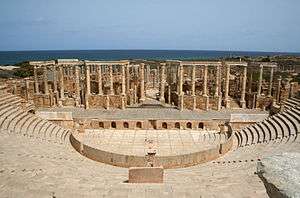 | ||||||||||||||||||||||||||||||||||||
|
||||||||||||||||||||||||||||||||||||
|
| ||||||||||||||||||||||||||||||||||||
Classical archaeology was used by the Italian authorities as a propaganda tool to justify their presence in the region. Before 1911, no archeological research was done in Tripolitania and Cyrenaica. By the late 1920s the Italian government had started funding excavations in the main Roman cities of Leptis Magna and Sabratha (Cyrenaica was left for later excavations because of the ongoing colonial war against Muslim rebels in that province). A result of the fascist takeover was that all foreign archaeological expeditions were forced out of Libya, and all archeological work was consolidated under a centralized Italian excavation policy, which exclusively benefitted Italian museums and journals.[42]
After Cyrenaica's full pacification, the Italian archaeological efforts in the 1930s were more focused on the former Greek colony of Cyrenaica than in Tripolitania, which was a Punic colony during the Greek period.[42] The rejection of Phoenician research was partly because of anti-Semitic reasons.[42] Of special interest were the Roman colonies of Leptis Magna and Sabratha, and the preparation of these sites for archaeological tourism.[42]
Tourism was further promoted by the creation of the Tripoli Grand Prix, a racing car event of international importance.[43]
See also
- List of colonial heads of Libya
- Italian invasion of Libya
- Italian Libya Railways
- Tripoli Grand Prix
- Frontier Wire (Libya)
- Italian Libyans
- Italian Tripoli
- Italian Benghazi
- Aozou Strip
- Italian Libyan Colonial Division
- 1st Libyan Division Sibelle
- 2 Libyan Division Pescatori
- Savari
- Spahis
References
- ↑ http://www.historyworld.net/wrldhis/PlainTextHistories.asp?historyid=aa83
- 1 2 3 4 5 Istat (December 2010). "I censimenti nell'Italia unita I censimenti nell'Italia unita Le fonti di stato della popolazione tra il XIX e il XXI secolo ISTITUTO NAZIONALE DI STATISTICA SOCIETÀ ITALIANA DI DEMOGRAFIA STORICA Le fonti di stato della popolazione tra il XIX e il XXI secolo" (PDF). Annali di Statistica. XII. 2: 269. Retrieved 24 December 2013.
- ↑ http://law.fsu.edu/library/collection/LimitsinSeas/IBS003.pdf
- ↑ W. Mitchell. Journal of the Royal United Service Institution, Whitehall Yard, Volume 57, Issue 2. p. 997.
- ↑ William James Makin. War Over Ethiopia. p. 227.
- ↑ "Districts of Libya". Statoids. Retrieved 10 November 2013.
- 1 2 Burr, J. Millard and Robert O. Collins, Darfur: The Long Road to Disaster, Markus Wiener Publishers: Princeton, 2006, ISBN 1-55876-405-4, p. 111
- ↑ Libyan colonial Troops: pp. 3031
- ↑ Stegemann, Bernd; Vogel, Detlef (1995). Germany and the Second World War: The Mediterranean, South-East Europe, and North Africa, 1939–1941. Oxford University Press. p. 176. ISBN 0-19-822884-8.
- ↑ Full analysis of the initial Italian attack
- ↑ This was assisted by orders from London withdrawing a large part of the Army to redeploy to Greece. According to German General Erwin Rommel "On 8th February (1941), leading troops of the British Army occupied El Agheila...Graziani's Army had virtually ceased to exist. all that remained of it were a few lorry columns and hordes of unarmed soldiers in full flight to the West. If Wavell (sic) had now continued his advance into Tripolitania, no significant resistance could have been mounted"
- ↑ Hagos, Tecola W., (November 20, 2004), "Treaty Of Peace With Italy (1947), Evaluation And Conclusion", Ethiopia Tecola Hagos. Retrieved July 18, 2006.
- ↑ Italians plan to see Libya once again
- 1 2 "Ratifica ed esecuzione del Trattato di amicizia, partenariato e cooperazione tra la Repubblica italiana e la Grande Giamahiria araba libica popolare socialista, fatto a Bengasi il 30 agosto 2008". Parliament of Italy. 2009-02-06. Retrieved 2009-06-10.(in Italian)
- 1 2 3 "Gaddafi to Rome for historic visit". ANSA. 2009-06-10. Retrieved 2009-06-10.
- ↑ "Berlusconi in Benghazi, Unwelcome by Son of Omar Al-Mukhtar". The Tripoli Post. 2008-08-30. Retrieved 2009-06-10.
- ↑ Ý bồi thường $5 tỉ, xin lỗi Libya về hậu quả thời đô hộ (Vietnamese)
- ↑ "Italia-Libia, firmato l'accordo". La Repubblica. 2008-08-30. Retrieved 2009-06-10.
- ↑ "Libya agrees pact with Italy to boost investment". Alarab Online. 2009-03-02. Retrieved 2009-06-10.
- ↑ The Report: Libya 2008. Oxford Business Group, 2008.Pp. 17.
- 1 2 3 4 Rodogno, D. (2006). Fascism's European empire: Italian occupation during the Second World War. p. 61.
- ↑ Italian colonists in Libia (in Italiano)
- 1 2 3 Jon Wright. History of Libya. P. 165.
- ↑ New villages in coastal Libya (in Italian)
- ↑ Michael R. Ebner. Geoff Simons. Ordinary Violence in Mussolini's Italy. New York, New York, USA: Cambridge University Press, 2011. P. 261.
- ↑ Mann, Michael (2006). The dark side of democracy: explaining ethnic cleansing (2nd ed.). Cambridge, England: Cambridge University Press. p. 309.
- ↑ Duggan 2007, p. 497
- ↑ Cardoza, Anthony L. (2006). Benito Mussolini: the first fascist. Pearson Longman. p. 109.
- ↑ Bloxham, Donald; Moses, A. Dirk (2010). The Oxford Handbook of Genocide Studies. Oxford, England: Oxford University Press. p. 358.
- 1 2 3 4 5 General History of Africa, Albert Adu Boahen,Unesco. International Scientific Committee for the Drafting of a General History of Africa, page 196, 1990
- ↑ Wright, John (1983). Libya: A Modern History. Kent, England: Croom Helm. p. 35.
- 1 2 3 4 Duggan, Christopher (2007). The Force of Destiny: A History of Italy Since 1796. New York: Houghton Mifflin. p. 496.
- ↑ Sarti, p 190
- ↑ Sarti, p194.
- ↑ Sarti, p196.
- ↑ 30,000 Libyans fought for Italy in WWII
- ↑ Chapter Libya (in Italian)
- ↑ Africa Under Colonial Domination 1880-1935, Professor A Adu Boahen,Unesco. International Scientific Committee for the Drafting of a General History of Africa, page 800, 1985
- ↑ Economic development of Italian Libya
- ↑ Helen Chapin Metz; Libya: A Country Study (see block-quote in text)
- ↑ Italian railways in colonial Libya (in italian)
- 1 2 3 4 Dyson, S.L (2006). In pursuit of ancient pasts: a history of classical archaeology in the 19th and 20h centuries. pp. 182–183.
- ↑ Video of Tripoli Grand Prix on YouTube
Bibliography
- Chapin Metz, Hellen. Libya: A Country Study. Washington: GPO for the Library of Congress, 1987.
- Del Boca, Angelo. Gli italiani in Libia. Vol. 2. Milano, Mondadori, 1997.
- Sarti, Roland. The Ax Within: Italian Fascism in Action. Modern Viewpoints. New York, 1974.
- Smeaton Munro, Ion. Through Fascism to World Power: A History of the Revolution in Italy. Ayer Publishing. Manchester (New Hampshire), 1971. ISBN 0-8369-5912-4
- Taylor, Blaine. Fascist Eagle: Italy's Air Marshal Italo B
- Tuccimei, Ercole. La Banca d'Italia in Africa, Foreword by Arnaldo Mauri, Collana storica della Banca d'Italia, Laterza, Bari, 1999.
- Taylor, Blaine. Fascist Eagle: Italy's Air Marshal Italo Balbo. Montana: Pictorial Histories Publishing Company, 1996. ISBN 1-57510-012-6
External links
- Photos of Libyan Italians and their villages in Libya
- (Italian) Italian colonial railways built in Libya
.svg.png)
.svg.png)
